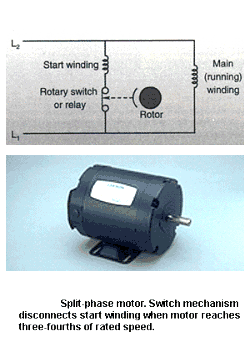The split-phase motor is a single-phase motor that does not have any capacitors or other devices in its circuit to alter its torque characteristics. Diagrams of this motor are presented in Fig. 1. This motor is also called the split-phase motor or the ISIR (induction start, induction run) motor, since it uses only induction to start and run.

Above: Fig. 1: Diagram of a split-phase motor connected to a forward and reversing motor starter. The run winding (T1-T4) remains connected
the same way in both forward and reverse operation. The start winding
(T5-T8) gets reversed to make the motor run in the opposite direction.
This type of motor has the lowest starting torque of all single-phase motors. It uses the physical displacement of the run and start windings in the stator to provide the phase shift required to start the rotor moving. Recall that the three-phase motor uses the 120° phase shift that naturally occurs in the three-phase voltage to cause starting torque. Since the single-phase motor does not have a natural phase shift, the split-phase motor uses the difference of the coil size to create a phase difference along with physically locating the start winding out of phase with the run winding to cause a magnetic phase shift that is large enough to cause the rotor to start spinning.
 When voltage is first applied to the motor's stator, the rotor is not
turning and the windings will draw maximum current. This current is called
inrush current or locked-rotor amperage (LRA). After the rotor starts
to turn, it will induce current from the stator and produce its own magnetic
field. This field will cause the rotor to increase speed until it reaches
its rated speed. The rated speed is determined by the number of poles
the motor uses and the frequency of the applied voltage. That is, at
a two-pole motor will operate at 3600 rpm, a four-pole motor will operate
at 1800 rpm, a six-pole motor will operate at 1200 rpm, and an eight-pole
motor will operate at 900 rpm.
When voltage is first applied to the motor's stator, the rotor is not
turning and the windings will draw maximum current. This current is called
inrush current or locked-rotor amperage (LRA). After the rotor starts
to turn, it will induce current from the stator and produce its own magnetic
field. This field will cause the rotor to increase speed until it reaches
its rated speed. The rated speed is determined by the number of poles
the motor uses and the frequency of the applied voltage. That is, at
a two-pole motor will operate at 3600 rpm, a four-pole motor will operate
at 1800 rpm, a six-pole motor will operate at 1200 rpm, and an eight-pole
motor will operate at 900 rpm.